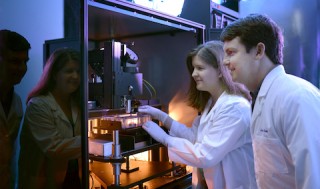Apr 20 2015
UT Southwestern Medical Center’s Texas Institute for Brain Injury and Repair (TIBIR) has acquired a pair of TissueCyte 1000 microscopes, the latest generation in serial two-photon laser imaging, as a centerpiece of its new Whole Brain Microscopy Facility.
 UT Southwestern’s Dr. Julian Meeks (right) and Dr. Denise Ramirez view a tissue sample at one of two new TissueCyte 1000 microscopes, the only ones of their kind in Texas and two of just a handful in existence around the world. UT Southwestern Medical Center
UT Southwestern’s Dr. Julian Meeks (right) and Dr. Denise Ramirez view a tissue sample at one of two new TissueCyte 1000 microscopes, the only ones of their kind in Texas and two of just a handful in existence around the world. UT Southwestern Medical Center
The TissueCyte microscopes are the only ones of their kind in Texas, and two of just a handful in existence around the world.
The Whole Brain Microscopy Facility will be a major resource for scientists researching traumatic brain injury and neurodegenerative diseases such as ALS, Alzheimer’s, Parkinson’s, and Huntington’s diseases.
The TissueCyte is uniquely engineered for high-throughput, fully-automated, whole-brain fluorescence imaging. In a matter of hours the system can produce 3D images of entire mouse or rat brains with micron-level resolution, revealing both healthy and damaged neuronal connections, and allowing researchers to evaluate potential therapies.
“The brain is composed of billions of neurons concentrated in a small space and connected in really complicated ways,” said Dr. Julian Meeks, Assistant Professor of Neuroscience at UT Southwestern, and director of the Whole Brain Microscopy Facility. “Mapping these connections has been the subject of neuroscientists’ dreams and nightmares since the late 1800s.”
Existing fluorescence microscopy technologies have allowed neuroscientists to start disentangling the brain’s many neuronal types and synaptic connections, but are labor-intensive and relatively slow. The new equipment utilizes automated multiphoton laser scanning and tissue sectioning to take high-resolution pictures in 3D in just hours. The resulting images constitute a virtual wiring diagram of the whole brain, enabling previously unfeasible studies into how brain connections are altered by injury or disease.
“Previously, for practical reasons, we would investigate just a couple of specific brain regions across many test subjects, or look exhaustively at just a couple of individual subjects,” Dr. Meeks said. “Testing hypotheses in this way has significant limitations. For example, we might have the right idea but be looking in the wrong place. To really understand the fundamentals of the injury and repair processes requires both high resolution and broad coverage. This innovation brings us to the doorstep of Big Data in research for neurology and neuroscience.”
A typical analysis from the TissueCyte may produce terabytes of data from the whole brains of multiple subjects, said Dr. Denise Ramirez, manager of the facility and an Instructor in the Department of Neurology and Neurotherapeutics. These data will be shared openly with other researchers, encouraging collaborative projects spanning multiple institutions.
The facility also includes state-of-the-art equipment for tissue preparation and automated slide scanning.
“The new imaging facility is at the forefront of neuroscience research,” said Dr. Mark Goldberg, Chair of the Department of Neurology and Neurotherapeutics, co-director of the TIBIR, and holder of the Linda and Mitch Hart Distinguished Chair in Neurology. “The ability to visualize individual neurons and their circuits in three dimensions will provide critical insights as we develop new treatments to prevent brain injury and promote repair.”
Funding for the $1.5 million initial investment was made available through the Texas Institute for Brain Injury and Repair, a state-funded initiative to promote innovative research and education, with the goals of accelerating translation into better diagnosis and revolutionizing care for millions of people who suffer brain injuries each year.